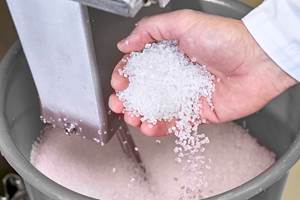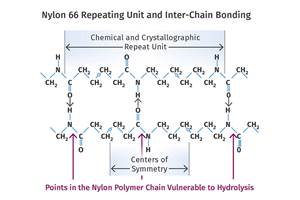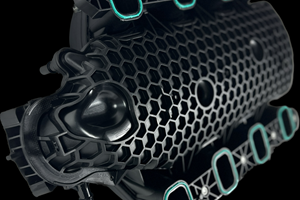Polymer Showdown — PPO vs. PA66: May the Best Material Win
Second in a series, an expert from plastics engineering consultancy The Madison Group pits leading thermoplastics against each other to see how they differ in processing characteristics, chemical resistance, thermal and mechanical performance, and more.
In the realm of high-performance polymers, poly(phenylene oxide) (PPO) and polyamide 6/6 (PA66) stand out as two popular choices, each with their own unique set of properties and applications. PPO, also known as PPE, is an amorphous thermoplastic with exceptional dimensional stability, hydrolytic stability and high heat resistance. PA66, on the other hand, is a semicrystalline polyamide with excellent tensile strength, toughness and wear resistance. In this polymer showdown, we will explore the strengths and weaknesses of PPO and PA66, comparing their chemical structures, thermal properties, mechanical properties, chemical resistance, environmental resistance and processing characteristics.
Molecular Structure
PA66 is characterized by its linear structure and amide linkages, enabling hydrogen bonding between polymer chains (Figure 1). This chemical structure enhances its tensile strength, toughness and chemical resistance. PA66 is semicrystalline, with ordered crystalline regions interspersed with amorphous regions.

FIG 1 — The chemical structure of PA66 enables hydrogen bonding at the amide groups. Source (all images): The Madison Group
PPO (Figure 2) is a miscible blend of poly(phenylene ether) and high-impact polystyrene (HIPS). PPE, an amorphous material, is known for its rigid molecular structure consisting of benzene rings and methyl groups. This structure contributes to its high glass-transition temperature, high heat resistance, good electrical properties, excellent hydrolytic stability and the ability to use nonhalogen flame-retardant packages. When blended with polystyrene (PS), the resulting material has tailorable thermal and mechanical performance properties.
FIG 2 — Chemical structure of a PPO containing PPE blended with polystyrene.
The comparison of these two materials is a classical battle of amorphous versus semicrystalline polymers. However, in the case of PA66, the unique chemical structure gives the material some benefits that other semicrystalline materials do not have in terms of toughness. The PPO material has advantages associated with amorphous materials with the addition of a more tailorable property set.
Thermal Properties
PA66, being a semicrystalline polymer, has a distinct melting point (Tm) around 260°C. Its glass transition temperature (Tg) ranges from 55°C (dry) to -37 °C (100% RH). The Tg of PA66 is influenced by moisture levels, as water acts as a plasticizer for the polymer backbones.
Comparison of the modulus versus temperature of PA66 and PPO shows the stark difference in thermal behavior between the amorphous and semicrystalline materials (Figure 3). PA66 has a glass transition temperature in the conditioned state that is reduced from the dry state. Above this glass transition, PA66 maintains modulus to a significantly higher temperature than a PPO material. If your primary goal is long-term, high-temperature performance of the type required for under-the-hood automotive applications, then PA66 is the better choice.
PPE boasts a high Tg of 215°C, providing excellent heat resistance and dimensional stability at elevated temperatures. Blending PPE with other polymers can influence its thermal transition temperatures. This can result in glass transitions ranging from 110°C for blends with higher PS content and 175°C for lower PS contents.
The thermal behavior of PPO can be characterized by stability, with a higher modulus from ambient temperatures up to the glass-transition temperature. Contrast this with polyamide materials that lose modulus as they go through the glass-transition temperature and have a modulus that depends significantly on the moisture content of the material. This leads to a material that you can trust to behave similarly within its useful temperature range.
FIG 3 — Modulus versus temperature comparison of PPO vs. PA66.

Table 1 — Property comparison of PPO and PA66.
PA66 exhibits good toughness, and resistance to impact, creep and fatigue. Its mechanical properties are influenced by moisture levels, with higher moisture leading to lower strength and stiffness but increased toughness. However, the stiffness and strength properties are tailorable with the addition of glass-fiber reinforcements.
In the conditioned state, PA66 has a lower tensile modulus but similar tensile strength to a PPO material. Additionally, the toughness of the polyamide is high and nearly matches the levels observed from the PPO material. This shows that while moisture dependency of polyamide materials can change the performance, it is still capable of providing sufficient strength and toughness for most applications. Added to this is its superior repeated impact toughness, low coefficient of friction and low wear resistance. PA66 has a very broad range of applications where it is better suited than PPO.
If your primary goal is long-term, high-temperature performance of the type required for under-the-hood automotive applications, then PA66 is the better choice.
PPO offers significant advantages over PA66, particularly in terms of mechanical and thermal properties. It exhibits consistently high stiffness and tensile/flexural strength, even under elevated temperatures. Only a gradual reduction in modulus occurs as temperature increases — an invaluable trait for applications demanding performance stability in challenging conditions. Moreover, PPO’s tensile strength remains essentially unaffected by humidity and maintains predictability across a wide temperature range. This makes it highly reliable when compared to PA66, which can experience strength degradation under similar environmental conditions. These features position PPO as a superior choice for applications requiring durability and performance consistency.
Chemical Resistance
PA66 exhibits excellent chemical resistance, making it a versatile material for various industries. It is highly resistant to hydrocarbons, oils and greases, which makes it suitable for automotive and industrial applications. PA66 also demonstrates good resistance to many solvents and weak acids. However, it is less resistant to strong acids, bases and oxidizing agents, which can degrade its structure over time. Its performance can vary with temperature and concentration of the chemicals to which it is exposed.
PA66 demonstrates superior chemical resistance when compared to PPO in specific applications, particularly environments exposed to hydrocarbons, oils and greases. PA66’s ability to withstand prolonged contact with these substances makes it highly advantageous for automotive and machinery components, where such exposure is commonplace. In contrast, PPO exhibits vulnerabilities to hydrocarbons, as well as aromatic solvents and ketones, which can limit its performance in similar scenarios. While PPO is resistant to a wide range of chemicals, its susceptibility to these specific substances places PA66 at a distinct advantage in applications requiring durability under such conditions. This resilience, combined with PA66’s mechanical strength, underscores its superiority in chemically demanding environments.
PPO exhibits excellent chemical resistance, particularly against acids, alkalis and many organic solvents. It is highly resistant to hydrolytic degradation and performs well in humid or wet environments due to its low moisture absorption. However, PPO is less resistant to aromatic hydrocarbons, halogens and certain ketones. Additionally, it is susceptible to environmental stress cracking when exposed to organic solvents.
While PPO being amorphous makes it more susceptible to chemical effects in general, there are multiple environments where it performs better than PA66. These environments would include contact with organic acids, inorganic chlorides, hydrogen peroxide and antifreeze exposure.
Environmental Resistance
PA66 exhibits notable environmental resistance, making it a reliable material for demanding applications. PA66 demonstrates excellent resistance to heat aging, maintaining its mechanical properties over extended periods at elevated temperatures. Specialized grades, such as glass-fiber-reinforced PA66, can endure exposure to temperatures up to 220°C, making it suitable for high-temperature environments. While PA66 is resistant to many chemicals, its hydrolytic stability can be affected by prolonged exposure to water or humid conditions, leading to dimensional changes and reduced mechanical performance. However, stabilizers are available that show improved stability under hydrothermal conditions. PA66 has limited inherent UV resistance, which can lead to surface degradation and discoloration when exposed to prolonged sunlight. To enhance its UV resistance, stabilizers or protective coatings are often added, making it more suitable for outdoor applications.
PPO is distinguished by its exceptional environmental resistance, particularly its ability to withstand moisture and hydrolytic degradation. With low moisture absorption, PPO maintains dimensional stability and mechanical properties even in humid or wet conditions, making it well suited for applications requiring long-term exposure to water. Additionally, PPO exhibits excellent resistance to a broad range of acids, alkalis and many organic solvents, ensuring durability in some chemically aggressive environments. Its inherent thermal stability complements its resistance, enabling it to perform reliably under varying environmental conditions.
PPO experiences only a gradual reduction in modulus as temperature increases — an invaluable trait for applications demanding performance stability in challenging conditions.
PPO surpasses PA66 in hydrolytic stability, boasting water absorption rates among the lowest of any engineering thermoplastic. This exceptional resistance to water uptake ensures that PPO maintains its mechanical integrity, with minimal property reduction or dimensional swelling. In contrast, nylon 6/6 absorbs moisture, leading to volume expansion and an increase in interference stress, while simultaneously losing stiffness and strength. PPO’s superior stability under humid or wet conditions makes it a more reliable choice for applications where dimensional accuracy and consistent mechanical performance are critical.
Processing
PA66, being semicrystalline, has many benefits when compared to molding PPO. Firstly, the melt viscosities of PA66 are lower than PPO. This leads to benefits in pressures required to fill the injection mold, enabling longer flow paths and the ability to fill thinner wall sections. PPO offers excellent dimensional control with low mold shrinkage. It also has a lower specific gravity than PA66, resulting in lighter parts.
Conclusions
The choice between PPO and PA66 depends on the specific application requirements. If your application requires a material that will excel when you need to roll up your sleeves and get dirty, PA66 is the clear winner. This includes automotive applications, industrial tools and higher temperature continuous service environments. PPO excels in applications demanding high heat resistance, dimensional stability and hydrolytic stability.
About the author: Richie Anfinsen is a graduate of Winona State University with a degree focused on the design, manufacturing and analysis of thermoset composites. Anfinsen is a senior project engineer at . He has run hundreds of failure and material investigations across medical, automotive, consumer and many other sectors. His project work has had a strong focus on material analysis and deformulation efforts, which have helped customers during initial design, manufacturing and failure-analysis efforts. Contact: 608-231-1907; richie.anfinsen@madisongroup.com; .
Related Content
Automotive Awards Highlight Emerging Technologies
Annual SPE Automotive event gives nods to several ‘firsts’ as well as sustainability.
Read MorePrices Up for All Volume Resins
First quarter was ending up with upward pricing, primarily due to higher feedstock costs and not supply/demand fundamentals.
Read MoreWhat is the Allowable Moisture Content in Nylons? It Depends (Part 1)
A lot of the nylon that is processed is filled or reinforced, but the data sheets generally don’t account for this, making drying recommendations confusing. Here’s what you need to know.
Read MoreBASF Highlighting How They 'Make, Use and Recycle Future Solutions'
NPE2024: BASF is using its proprietary computer-aided engineering tool Ultrasim when designing for sustainability in a broad range of industries.
Read MoreRead Next
The Long and Short of It (Part 1)—Tips for Molding Long Fiber-Reinforced Polymers
In Part 1 of this series, we address long-fiber processing fundamentals and best practices, including practical tips and guidance on maintaining fiber length and deriving maximum advantages for demanding end applications. Part 2 will provide the same information for short-fiber materials.
Read MorePolymer Showdown — PC/ABS vs. PC/PBT — May the Best Material Win
First in a series, experts from plastics engineering consultancy The Madison Group will pit leading thermoplastics against each other to see how they differ in processing characteristics, chemical resistance, thermal and mechanical performance, and more.
Read MoreTracing the History of Polymeric Materials: Polyphenylene Oxide Blends
PPO was a promising new high-performance thermoplastic, but it could be made useful only by mixing it with a humble commodity resin.
Read More











